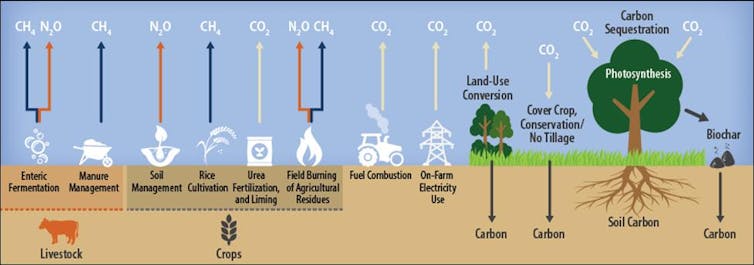Xiaoming Xu Postdoctoral Research Associate in Atmospheric Sciences, University of Illinois at Urbana-Champaign
Atul Jain Professor of Atmospheric Sciences, University of Illinois at Urbana-Champaign
In a new study, we show that the food system generates about 35% of total global man-made greenhouse gas emissions.
Breaking down this share,
production of animal-based foods – meat,
poultry and dairy products, including growing crops to feed livestock
and pastures for grazing – contributes 57% of emissions linked to the
food system.
Raising plant-based foods for human consumption contributes
29%.
The other 14% of agricultural emissions come from products not
used as food or feed, such as cotton and rubber.
We are atmospheric scientists who study the effects of agriculture and other human activities
on Earth’s climate. It’s well known that producing animal-based foods
generates more greenhouse gas emissions than plant-based foods, which is
why shifting toward a more plant-based diet is recognized as an option for curbing greenhouse gas emissions and climate change.
...
Land use change – clearing forests for farms and ranches, which
reduces carbon storage in trees and soils – accounts for 29% of total
food production greenhouse gas emissions. Another 38% comes from
farmland management activities, such as plowing fields, which reduces
soil carbon storage, and treating crops with nitrogen fertilizer.
Farmers also burn a lot of fossil fuel to run their tractors and
harvesters.
Raising livestock generates 21% of greenhouse gas emissions from food production. It includes methane belched by grazing animals,
as well as methane and nitrous oxide released from livestock manure.
The remaining 11% comes from activities that occur beyond farm gates,
such as mining, manufacturing and transporting fertilizers and
pesticides, as well as energy use in food processing.

Among animal-based foods, beef is the largest contributor to climate
change. It generates 25% of total food emissions, followed by cow milk
(8%) and pork (7%).
Rice is the largest contributor among plant-based foods, producing
12% of the total greenhouse gas emissions from the food sector, followed
by wheat (5%) and sugarcane (2%). Rice stands out because it can grow
in water, so many farmers flood their fields to kill weeds, creating
ideal conditions for certain bacteria that emit methane.
Among individual countries, China, India and Indonesia have the
highest emissions from plant-based food production, contributing 7%, 4%,
and 2% respectively of global food-related greenhouse gas emissions.
The countries with leading emissions from the production of animal-based
foods are China (8%), Brazil (6%), the U.S. (5%) and India (4%).
Our framework also shows that raising animal-based foods consumes six times as much land as producing plant-based foods.
we estimate that 13% of total agricultural land is being used to produce
plant-based foods. The other 77% is being used to produce animal-based
foods, including croplands that are growing animal feed and grazing
lands. The remaining 10% is being used to raise other products, such as
cotton, rubber and tobacco.
https://theconversation.com/food-production-generates-more-than-a-third-of-manmade-greenhouse-gas-emissions-a-new-framework-tells-us-how-much-comes-from-crops-countries-and-regions-167623
